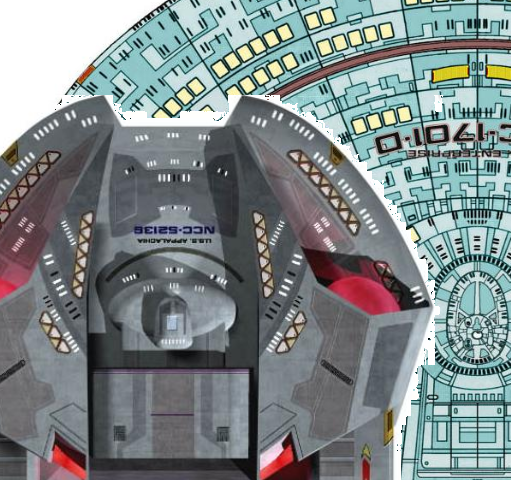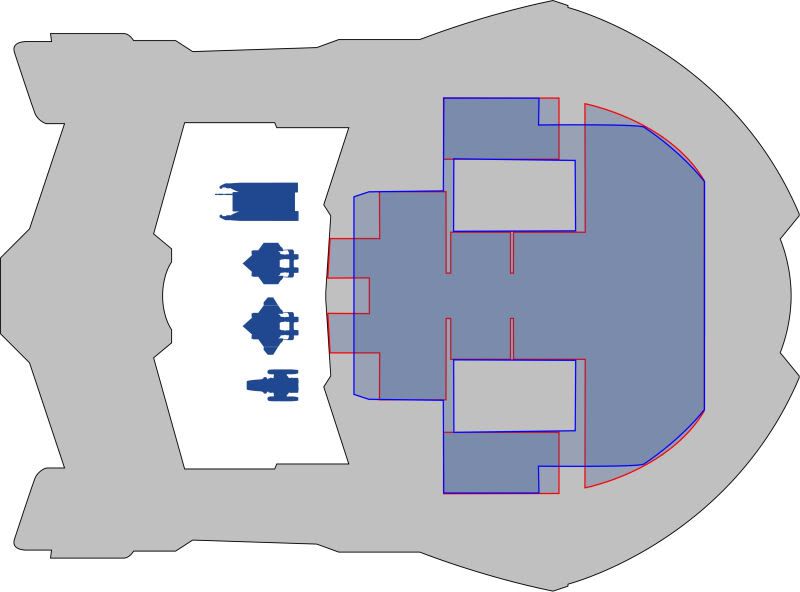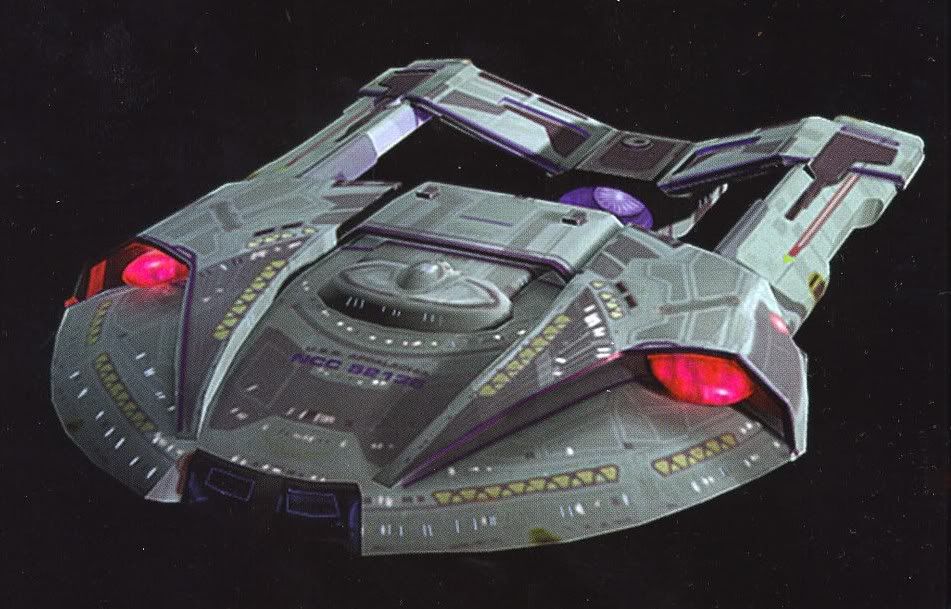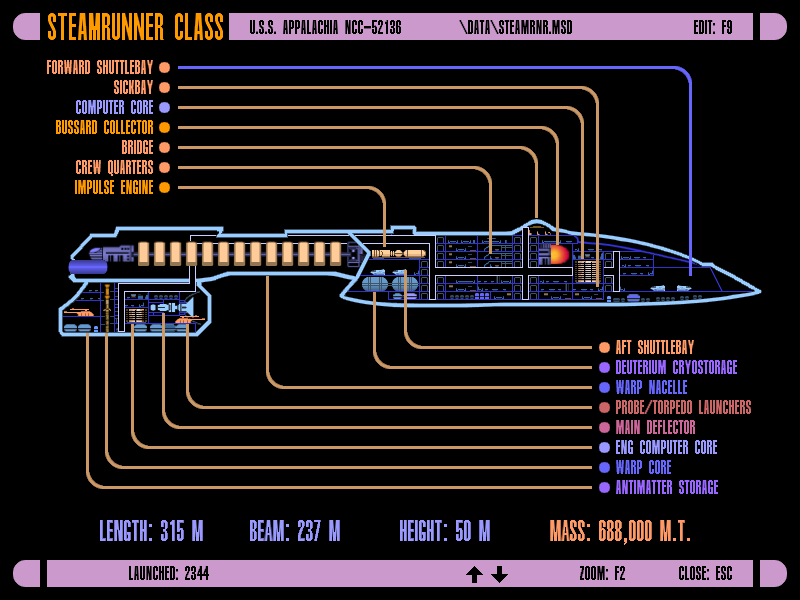-
Welcome! The TrekBBS is the number one place to chat about Star Trek with like-minded fans.
If you are not already a member then please register an account and join in the discussion!
You are using an out of date browser. It may not display this or other websites correctly.
You should upgrade or use an alternative browser.
You should upgrade or use an alternative browser.
Steamrunner class
- Thread starter Bill Morris
- Start date
Well in my head, most of the interior of the saucer is essentially hollow, so having a 4.5 meter deck height is not a bad idea as it allows for allot of the machinery like life support, the ODN & EPS conduits to be pushed into the in-between spaces around the "outer shell" that is the crew/habitat sections of the primary hull.
Also I would conjecture that the uneven nature of the outer hull is in part due to the crew sections being constructed in modules around the cargo sections, as opposed to a normal ship where the cargo areas are fitted in and around the habitats.
Okay, here's an image with more open space. Feel free to experiment, shift things around if necessary,
and show me what you would put in there.

LCARS 24, I made you an animated avatar -


Got it. Thanks, Carpe Occasio.
Okay, here's what happens when you match up Steamrunner at 355 m and Galaxy at 642.5 m total length at 2 pixels per meter. The windows? Yeah. Escape pods? Out of proportion, unless you make the Steamrunner bigger. But the design doesn't seem to go with a such a large ship, and 3.5 m deck to deck (after figuring in the extra space at the curvature of the hull and bridge. in the 315 m scenario does sound reasonable. The Nova class measures out nicely to 3.5 per deck, as demonstrated at Ex Astris Scientia.

I'd be hesitant to use anything but the original and not trust in fan renderings too much. Still, as I said before, the relative deck heights aren't much of a problem, the proportions of the escape pods depends on exactly what model pod the Steamrunner is using (it could be a slightly different one than the one used on the Sovereign) and as for the look of the overall design looking "smaller", remember that the original model was a low-res , mostly image mapped background mesh, so the detail isn't going to be that great.
I could explain the relatively small number of windows in a way that re-enforces my hollow hull concept in that allot of the facilities and systems that you'd usually have in the inner rings of a normal ship's saucer (sickbay, security, stellar cartography, transporter rooms) have been pushed to the edge to make room for the huge cargo/shuttle facilities. So the only windows visible are the ones that are in crew and rec type facilities.
As for the MSD, I wouldn't presume to alter your work, but so far, this is a rough diagram of the the kind of internal layout that I have in mind.

The blue out lined area taking up the three or so decks from the large shuttlebay upwards (the p/s may be a bit lower to allow for the nacelles) and the red out lined area would be the three or so decks below. That is, in line with the two smaller aft launch bays and below. That still leaves a few more decks below for ventral loading bays, cargo lifts and possibly even landing gear.
Of course a centreline section of this would have the ship being practically hollow, but then a cross-section can easily give a false impression as you can see there's still plenty of internal floorspace.
Okay, and that aft shuttlebay can be have a ceiling as high as you like between the impulse engines, and what you show there still fits with the MSD on the previous page. With the dimensions I showed, the forward (see below) and aft shuttlebay doors are still nearly 7 meters high, (barely) sufficient for Danube class with pod, allowing for huge open spaces in the central part of the main hull while preserving sensible deck spacing of 3.5 m for everything else.
And don't say the bridge module looks like a sombrero!)

And don't say the bridge module looks like a sombrero!)

I've never been sure if those features were meant to be shuttlebays or and aux deflector system. I'd say the blue glow supports the deflector idea, but then the Miranda has an exterior blue glow on it's aft bays, even when the door is closed, so it's hardly conclusive.
Still, it those are shuttlebays (which, to be honest they probably are), I'd have them as separate facilities to the rest of the inner cargo area, used mostly for everyday shuttle ops like the E-D's bays 2 & 3.
Of course you shouldn't feel beholden to my preference for a slightly larger scale Steamrunner, the fact is that either option is possible and it's mostly down to personal preference.
...and what is it with sombreros on this board anyway?
Still, it those are shuttlebays (which, to be honest they probably are), I'd have them as separate facilities to the rest of the inner cargo area, used mostly for everyday shuttle ops like the E-D's bays 2 & 3.
Of course you shouldn't feel beholden to my preference for a slightly larger scale Steamrunner, the fact is that either option is possible and it's mostly down to personal preference.
...and what is it with sombreros on this board anyway?
And I did some cleanup of the images for the Ent-C and Ent-D MSDs. Hopefully, they're okay now.


Sombreros? It's a running joke in the Star Trek XI forum thread Blue Warp Nacelles? about what J.J. might be doing to the TOS Enterprise.


Sombreros? It's a running joke in the Star Trek XI forum thread Blue Warp Nacelles? about what J.J. might be doing to the TOS Enterprise.
Last edited:
A minor suggestion for the Steamrunner's MSD. It might be interesting to show a turboshaft running along the top of the nacelle. Unlike say, the Oberth, the nacelle pylons are thick enough to support turbolift access. In fact, I see no reason why they pylons themselves couldn't have a re-oriented gravity field and be decks in their own right.
I'll do that. I was thinking the exact same thing last week (brought on by the Oberth discussion and wondering how people get to and from the Steamrunner pod) when I was outside and then forgot about it. What I didn't do was look at the thickness of the pylons. That's the key.
Thanks, Reverend. That helps.
Now people won't be joking about beaming or sliding along a cable.

Thanks, Reverend. That helps.
Now people won't be joking about beaming or sliding along a cable.

Last edited:
With the way this is developing, the Steamrunner is looking good for taking up the role of the Miranda class, which was already aging when the registry numbers associated with the class suggest that it originated in.
Broadly speaking, I'd agree. Though it comes at it's function from the opposite direction of the Miranda. Where the Miranda is a destroyer/escort that can be adapted into a science vessel or transport, the Steamrunner would be a transport/science vessel that can be adapted as a destroyer/carrier.
Yeah, 355 meters seems a bit steep, though that is the length given at Ex Astris Scientia, which has a pretty good rep for accuracy. Memory Alpha gives a stat of 244m long x 179m wide x 41m tall, which could shrink it further. I don't see how scaling it down any more would allow small craft to fit in the bays shown, though, and 355m makes it look too damn big when compared to the Akira and Sovereign.
I settled on 315 meters, based on a deck layout that fits with the exterior clues and puts the height at 50 meters.
That one's a can of worms, with a bit of disagreement about its configuration.
I downsized the shuttles in the Steamrunner image, since they're supposed to be 2.8 meters tall.
The lastest addition shows what will be carrying U.S. astronauts to and from the ISS after the Space Shuttle is retired:
http://lcars24.com/nasasch6.html
I downsized the shuttles in the Steamrunner image, since they're supposed to be 2.8 meters tall.
The lastest addition shows what will be carrying U.S. astronauts to and from the ISS after the Space Shuttle is retired:
http://lcars24.com/nasasch6.html
Perhaps keeping the kaboomables away from the main hull is a smart thing to do in the usual case?
Main engineering might only get buried inside the primary hull in those ships that are dedicated combatants and already destined to die horribly. Ships designed for more sedate lives take steps to minimize the risks and place their engines and powerplants far away from the important bits.
Granted, the Steamrunner is seen in frontline combat quite often. But her role might still be something else than ship-to-ship combat, something more oriented towards exploration, or transport. Another prominent characteristic of hers is very large warp engines in relation to overall size; perhaps she's intended to be very fast?
Timo Saloniemi
Main engineering might only get buried inside the primary hull in those ships that are dedicated combatants and already destined to die horribly. Ships designed for more sedate lives take steps to minimize the risks and place their engines and powerplants far away from the important bits.
Granted, the Steamrunner is seen in frontline combat quite often. But her role might still be something else than ship-to-ship combat, something more oriented towards exploration, or transport. Another prominent characteristic of hers is very large warp engines in relation to overall size; perhaps she's intended to be very fast?
Timo Saloniemi
Exactly. And, as Reverend has suggested, it has the facilities to accommodate a number of Peregrine-class fighters. etc. if the mission so requires.
Here's the final version:

Here's the final version:

Perhaps keeping the kaboomables away from the main hull is a smart thing to do in the usual case?
Main engineering might only get buried inside the primary hull in those ships that are dedicated combatants and already destined to die horribly. Ships designed for more sedate lives take steps to minimize the risks and place their engines and powerplants far away from the important bits.
Captain: "Yeah, engineering, we see that the warp cores about to go, so we're just going to jettison that entire area."
Chief Engineer: "Wait, what?
Captain: "But hey, thanks for a job well done. I'll put you in for a medal or something."
Chief: "Oh, you motherfu---" <Transmission lost>

Granted, the Steamrunner is seen in frontline combat quite often. But her role might still be something else than ship-to-ship combat, something more oriented towards exploration, or transport. Another prominent characteristic of hers is very large warp engines in relation to overall size; perhaps she's intended to be very fast?
Timo Saloniemi
Well, in Armada II, they acted like artillery, their torpedo launchers had a longer range for some reason.
But nonetheless, the Steamrunner is one of my favorite classes and I'm seriously considering using her in a fanfic at some point.

Similar threads
- Replies
- 0
- Views
- 372
- Replies
- 547
- Views
- 47K
If you are not already a member then please register an account and join in the discussion!
